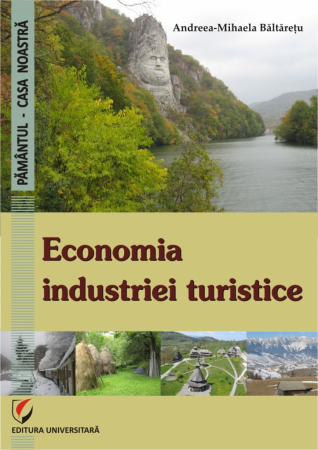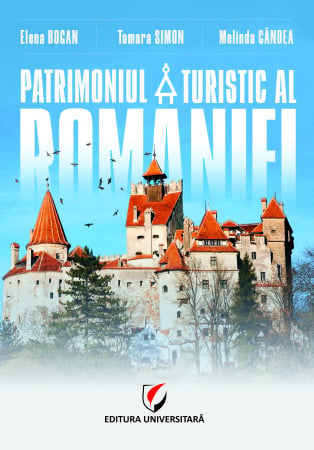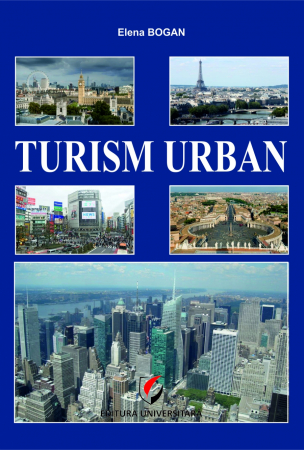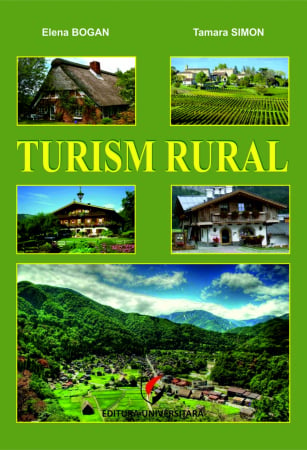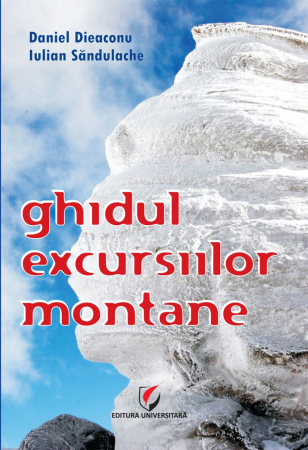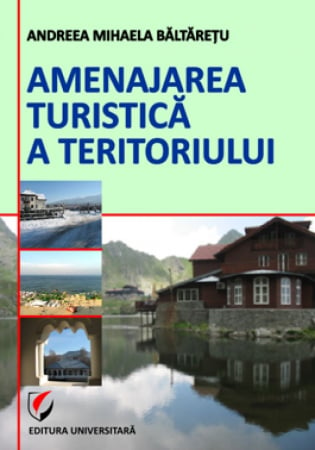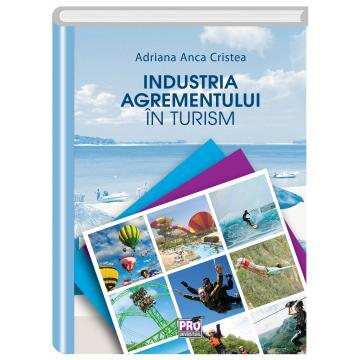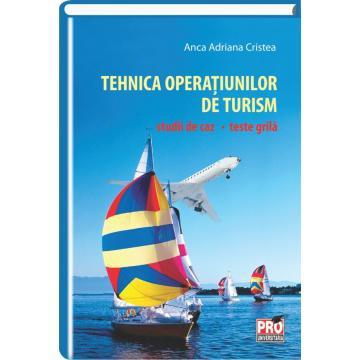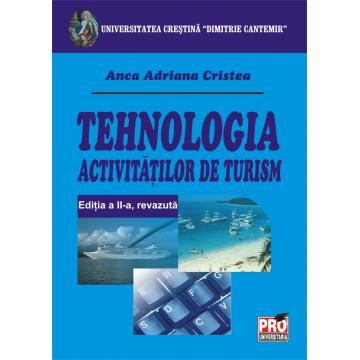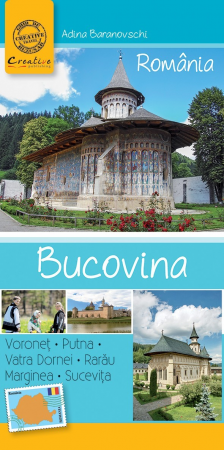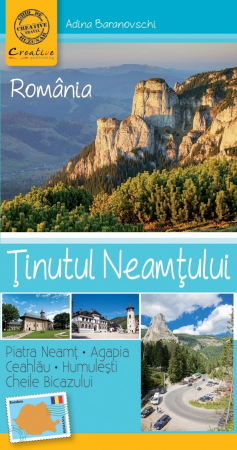Manuscript proposals: [email protected] / 0745 204 115 //// Tracking orders Individuals / Sales: 0745 200 357 / Orders Legal entities: 0721 722 783
6359.png) Resources and tourist destinations in Romania. Third edition, revised and added - Andreea Baltaretu, Marcela Draghila, Monica Neacsu, Nicolae Neacsu
Resources and tourist destinations in Romania. Third edition, revised and added - Andreea Baltaretu, Marcela Draghila, Monica Neacsu, Nicolae Neacsu
6359.png)
ISBN: 978-606-28-0421-3
DOI: 10.5682/9786062804213
Publisher year: 2016
Edition: III, revizuita si adaugita
Pages: 598
Publisher: Editura Universitară
Author: Nicolae Neacşu, Andreea Baltaretu, Monica Neacşu, Marcela Drăghilă
Product Code:
9786062804213
Do you need help?
0745 200 357
- Description
- Download (1)
- Authors
- Content
- More details
- Reviews (0)
The paper exhaustively addresses the issue of resources and tourist destinations for Romania. For the regions and countries of the world, the information and training are completed by creating and editing the work "Resources and tourist destinations. Case studies, statistics, regulations and UNWTO documents” by the same authors, by elaborating some projects aiming at the tourist resources and destinations in country “x”, projects that are presented at the debates at seminars or master's degrees.
Through its content and structuring, through rich documentation on resources and tourist destinations in Romania, the book is addressed to specialized university and high school education (geography, economy and services, tourism, international relations, etc.), masters in tourism, managers and workers from tourism, as well as to all those passionate about the tourist phenomenon, the tourist culture. Also, the work in question can be used as a tourist guide of Romania, in the case of those in love with travel.
Through its content and structuring, through rich documentation on resources and tourist destinations in Romania, the book is addressed to specialized university and high school education (geography, economy and services, tourism, international relations, etc.), masters in tourism, managers and workers from tourism, as well as to all those passionate about the tourist phenomenon, the tourist culture. Also, the work in question can be used as a tourist guide of Romania, in the case of those in love with travel.
-
Resurse si destinatii turistice in Romania
Download
NICOLAE NEACSU
ANDREEA BALTARETU
MONICA NEACSU
MARCELA DRAGHILA
ANDREEA BALTARETU
MONICA NEACSU
MARCELA DRAGHILA
FOREWORD / 5
CHAPTER 1. INTRODUCTORY ELEMENTS REGARDING TOURIST RESOURCES AND DESTINATIONS / 13
1.1. Tourist potential and tourist resources / 13
1.2. Tourist destination: definition, content, typology / 27
1.3. The image and the brand of the tourist destination / 38
1.4. Country brand case studies / 43
CHAPTER 2. REGIONS AND TOURIST DESTINATIONS IN ROMANIA / 56
2.1. General presentation of the regions of Romania / 59
2.2. The technical-material base and the tourist circulation in the regions of Romania in 2014 and 2015/64
CHAPTER 3. RESOURCES AND MAIN TOURIST DESTINATIONS IN THE NORTH-EAST DEVELOPMENT REGION / 70
3.1. Bacau County / 75
3.2. Botosani County / 84
3.3. Iasi County / 93
3.4. Neamt County / 103
3.5. Suceava County / 117
3.6. Vaslui County / 132
CHAPTER 4. RESOURCES AND MAIN TOURIST DESTINATIONS IN THE SOUTH-EAST DEVELOPMENT REGION / 140
4.1. Braila County / 145
4.2. Buzau County / 153
4.3. Constanta County / 166
4.4. Galati County / 186
4.5. Tulcea County / 191
4.6. Vrancea County / 204
CHAPTER 5. RESOURCES AND MAIN TOURIST DESTINATIONS IN THE SOUTH-MUNTENIA DEVELOPMENT REGION / 211
5.1. Arges County / 216
5.2. Calarasi County / 225
5.3. Dambovita County / 237
5.4. Giurgiu County / 243
5.5. Ialomita County / 249
5.6. Prahova County / 255
5.7. Teleorman County / 271
CHAPTER 6. RESOURCES AND MAIN TOURIST DESTINATIONS IN THE SOUTH-WEST DEVELOPMENT REGION OLTENIA / 277
6.1. Dolj County / 282
6.2. Gorj County / 290
6.3. Mehedinti County / 301
6.4. Olt County / 315
6.5. Valcea County / 321
CHAPTER 7. RESOURCES AND MAIN TOURIST DESTINATIONS IN THE WEST DEVELOPMENT REGION / 335
7.1. Arad County / 339
7.2. Caras-Severin County / 348
7.3. Hunedoara County / 361
7.4. Timis County / 379
CHAPTER 8. RESOURCES AND MAIN TOURIST DESTINATIONS IN THE NORTH-WEST DEVELOPMENT REGION / 387
8.1. Bihor County / 392
8.2. Bistrita-Nasaud County / 404
8.3. Cluj County / 413
8.4. Maramures County / 424
8.5. Satu Mare County / 439
8.6. Salaj County / 447
CHAPTER 9. RESOURCES AND MAIN TOURIST DESTINATIONS IN THE CENTER DEVELOPMENT REGION / 458
9.1. Alba County / 464
9.2. Brasov County / 487
9.3. Covasna County / 503
9.4. Harghita County / 533
9.5. Mures County / 527
9.6. Sibiu County / 537
CHAPTER 10. RESOURCES AND MAIN TOURIST DESTINATIONS IN THE BUCHAREST-ILFOV DEVELOPMENT REGION / 563
10.1. Ilfov County / 568
10.2. Bucharest / 575
BIBLIOGRAPHY / 586
CHAPTER 1. INTRODUCTORY ELEMENTS REGARDING TOURIST RESOURCES AND DESTINATIONS / 13
1.1. Tourist potential and tourist resources / 13
1.2. Tourist destination: definition, content, typology / 27
1.3. The image and the brand of the tourist destination / 38
1.4. Country brand case studies / 43
CHAPTER 2. REGIONS AND TOURIST DESTINATIONS IN ROMANIA / 56
2.1. General presentation of the regions of Romania / 59
2.2. The technical-material base and the tourist circulation in the regions of Romania in 2014 and 2015/64
CHAPTER 3. RESOURCES AND MAIN TOURIST DESTINATIONS IN THE NORTH-EAST DEVELOPMENT REGION / 70
3.1. Bacau County / 75
3.2. Botosani County / 84
3.3. Iasi County / 93
3.4. Neamt County / 103
3.5. Suceava County / 117
3.6. Vaslui County / 132
CHAPTER 4. RESOURCES AND MAIN TOURIST DESTINATIONS IN THE SOUTH-EAST DEVELOPMENT REGION / 140
4.1. Braila County / 145
4.2. Buzau County / 153
4.3. Constanta County / 166
4.4. Galati County / 186
4.5. Tulcea County / 191
4.6. Vrancea County / 204
CHAPTER 5. RESOURCES AND MAIN TOURIST DESTINATIONS IN THE SOUTH-MUNTENIA DEVELOPMENT REGION / 211
5.1. Arges County / 216
5.2. Calarasi County / 225
5.3. Dambovita County / 237
5.4. Giurgiu County / 243
5.5. Ialomita County / 249
5.6. Prahova County / 255
5.7. Teleorman County / 271
CHAPTER 6. RESOURCES AND MAIN TOURIST DESTINATIONS IN THE SOUTH-WEST DEVELOPMENT REGION OLTENIA / 277
6.1. Dolj County / 282
6.2. Gorj County / 290
6.3. Mehedinti County / 301
6.4. Olt County / 315
6.5. Valcea County / 321
CHAPTER 7. RESOURCES AND MAIN TOURIST DESTINATIONS IN THE WEST DEVELOPMENT REGION / 335
7.1. Arad County / 339
7.2. Caras-Severin County / 348
7.3. Hunedoara County / 361
7.4. Timis County / 379
CHAPTER 8. RESOURCES AND MAIN TOURIST DESTINATIONS IN THE NORTH-WEST DEVELOPMENT REGION / 387
8.1. Bihor County / 392
8.2. Bistrita-Nasaud County / 404
8.3. Cluj County / 413
8.4. Maramures County / 424
8.5. Satu Mare County / 439
8.6. Salaj County / 447
CHAPTER 9. RESOURCES AND MAIN TOURIST DESTINATIONS IN THE CENTER DEVELOPMENT REGION / 458
9.1. Alba County / 464
9.2. Brasov County / 487
9.3. Covasna County / 503
9.4. Harghita County / 533
9.5. Mures County / 527
9.6. Sibiu County / 537
CHAPTER 10. RESOURCES AND MAIN TOURIST DESTINATIONS IN THE BUCHAREST-ILFOV DEVELOPMENT REGION / 563
10.1. Ilfov County / 568
10.2. Bucharest / 575
BIBLIOGRAPHY / 586
Tourism in the world is one of the most spectacular phenomena that characterize the last decades of the twentieth century and the beginning of the twenty-first century. An activity of great complexity, with profound economic, social, cultural-educational and religious implications, tourism in the world has managed to "coexist" with globalization, regional / global crises and even acts of terrorism. This reality is demonstrated by the figures communicated by the World Tourism Organization (O.M.T.): in 2012 = 1035 million arrivals internationally (exceeding the "psychological threshold" of 1 billion arrivals); in 2013 = 1087 million arrivals; in 2014 = 1133 million arrivals.
These figures reveal the fact that tourism is developing continuously, worldwide, with differentiations by regions / countries, the growth rates being slower compared to the O.M.T. forecasts, elaborated and differentiated years ago.
All countries of the world have been endowed with a great diversity of natural resources, and the peoples of these countries have created anthropogenic resources (cultural-historical and religious, technical-economic and socio-demographic) throughout their existence.
Thus, all countries of the world - large or small - at certain times are inscribed on the "world tourism map" by the natural, economic-social, historical, religious, language, culture and civilization, which make their mark on the tourist dowry.
The development of tourism presupposes the existence of a tourist potential which, through its attractiveness, has the purpose to incite and ensure the integration of an area, regions, countries with tourist vocation in the domestic and international circuits and to allow the access of tourists through appropriate arrangements.
Among the components of the tourist potential must be mentioned, first of all, the natural resources (eg: mountain and landscape beauties, beaches on the coast, the healing factors in the balneo-climatic resorts, climate, vegetation, fauna, other attractions of scientific interest, with character of unique etc.).
In a decisive sense, the natural values (the so-called primary offer) constitute the basis of the potential tourist offer of an area, considered as suitable to be introduced in the tourist circuits.
The natural resources (values) are completed with the anthropic resources (values), created by the human mind and hand (the so-called secondary tourist offer), meant to enrich and facilitate the sustainable capitalization of the natural tourist potential, ensuring the premises for transforming this potential offer. an effective tourist offer.
The natural conditions are imposed by picturesque sea attractions, being present everywhere on Earth, from the highest mountains to the most arid plains and deserts, from the American, African, Australian national parks, etc., to the sea and ocean coasts or the great expanses with eternal ice.
The history and civilization of each people enrich the natural values of that country and also impose a certain "cultural-tourist brand", original, unmistakable in the world. Many artistic, scientific, architectural, technical-engineering creations, etc., have revolutionized the world since then and marvel and inflame the minds of our contemporaries. In this sense, we mention for tourism the vestiges of the Hellenistic, Roman, Aztec, Inca, Jewish, Arab, Buddhist or African civilizations, etc., and closer to us, in Europe, the renaissance, medieval, Byzantine, Ottoman art, etc.
The enhancement of natural resources (primary supply) and resources created (secondary supply) in an area, resort, etc., of tourist interest depends, to a large extent, on the dynamism of the development of a country's national economy, on the overall policy which is promoted by one or another of the countries receiving tourists in the field of tourism development, by the facilities offered to attract visitors.
Any tourism development strategy starts from the evaluation and ranking of tourist resources which represent the "raw material" for all tourist activities.
There is a close link between the location of tourist resources and the development of tourism, between the variety and quality of these resources and the forms of tourism practiced, between the dimensions of traffic and the tourist phenomenon and the contouring of tourist areas, respectively stability and viability of rural and urban settlements.
The socio-economic conditions and especially the financial and technological ones are decisive in the level of capitalization of the tourist resources. These conditions are linked to the introduction of new tourist areas in the circuit, including some of the most inhospitable, such as the desert ones in America (with the famous tourist centers: Las Vegas, Santa Fe, Phoenix), Sahara (Tunisia, Egypt, Republic of South Africa ) and Australia or polar (Argentina, Canada, Finland, Russian Federation). Modern technologies are used in landscaping high mountain areas (USA, Austria, Switzerland), of the marine or oceanic coasts (Australia, USA, Mediterranean Europe, Republic of South Africa), of certain natural attractions (canyons, waterfalls - Niagara - USA and Canada), or in the realization of some tourist structures or equipments of the most sophisticated , casinos, cruise ships, leisure and sports facilities). Therefore, these regions are among the most requested destinations by tourists.
The authors welcome with full satisfaction the introduction (starting with the academic year 2008/2009) in the program of the Faculty of Tourism and Commercial Management of the discipline "Tourist resources and destinations" because it "arms" future specialists - managers - travel agents-guides, etc. from Romanian tourism both with the elements necessary for tourism development programs in areas, resorts, regions, counties (in-depth knowledge of tourist resources), and with the elements necessary for an efficient capitalization of the domestic and international tourist offer (knowledge of tourist destinations).
The paper exhaustively addresses the issue of resources and tourist destinations for Romania. For the regions and countries of the world, the information and training are completed by creating and editing the work "Resources and tourist destinations. Case studies, statistics, regulations and UNWTO documents” by the same authors, by elaborating some projects aiming at the tourist resources and destinations in country “x”, projects that are presented at the debates at seminars or master's degrees.
Through its content and structuring, through rich documentation on resources and tourist destinations in Romania, the book is addressed to specialized university and high school education (geography, economy and services, tourism, international relations, etc.), masters in tourism, managers and workers from tourism, as well as to all those passionate about the tourist phenomenon, the tourist culture. Also, the work in question can be used as a tourist guide of Romania, in the case of those in love with travel.
The authors of this volume would like to thank, in particular, those who wrote in the field of tourism (mentioned in the bibliography), for the indirect involvement in the realization of this new specialized work.
Also, we thank in advance those who will send observations and suggestions for completing and improving the content of the present work in the perspective of new editions.
THE AUTHORS
These figures reveal the fact that tourism is developing continuously, worldwide, with differentiations by regions / countries, the growth rates being slower compared to the O.M.T. forecasts, elaborated and differentiated years ago.
All countries of the world have been endowed with a great diversity of natural resources, and the peoples of these countries have created anthropogenic resources (cultural-historical and religious, technical-economic and socio-demographic) throughout their existence.
Thus, all countries of the world - large or small - at certain times are inscribed on the "world tourism map" by the natural, economic-social, historical, religious, language, culture and civilization, which make their mark on the tourist dowry.
The development of tourism presupposes the existence of a tourist potential which, through its attractiveness, has the purpose to incite and ensure the integration of an area, regions, countries with tourist vocation in the domestic and international circuits and to allow the access of tourists through appropriate arrangements.
Among the components of the tourist potential must be mentioned, first of all, the natural resources (eg: mountain and landscape beauties, beaches on the coast, the healing factors in the balneo-climatic resorts, climate, vegetation, fauna, other attractions of scientific interest, with character of unique etc.).
In a decisive sense, the natural values (the so-called primary offer) constitute the basis of the potential tourist offer of an area, considered as suitable to be introduced in the tourist circuits.
The natural resources (values) are completed with the anthropic resources (values), created by the human mind and hand (the so-called secondary tourist offer), meant to enrich and facilitate the sustainable capitalization of the natural tourist potential, ensuring the premises for transforming this potential offer. an effective tourist offer.
The natural conditions are imposed by picturesque sea attractions, being present everywhere on Earth, from the highest mountains to the most arid plains and deserts, from the American, African, Australian national parks, etc., to the sea and ocean coasts or the great expanses with eternal ice.
The history and civilization of each people enrich the natural values of that country and also impose a certain "cultural-tourist brand", original, unmistakable in the world. Many artistic, scientific, architectural, technical-engineering creations, etc., have revolutionized the world since then and marvel and inflame the minds of our contemporaries. In this sense, we mention for tourism the vestiges of the Hellenistic, Roman, Aztec, Inca, Jewish, Arab, Buddhist or African civilizations, etc., and closer to us, in Europe, the renaissance, medieval, Byzantine, Ottoman art, etc.
The enhancement of natural resources (primary supply) and resources created (secondary supply) in an area, resort, etc., of tourist interest depends, to a large extent, on the dynamism of the development of a country's national economy, on the overall policy which is promoted by one or another of the countries receiving tourists in the field of tourism development, by the facilities offered to attract visitors.
Any tourism development strategy starts from the evaluation and ranking of tourist resources which represent the "raw material" for all tourist activities.
There is a close link between the location of tourist resources and the development of tourism, between the variety and quality of these resources and the forms of tourism practiced, between the dimensions of traffic and the tourist phenomenon and the contouring of tourist areas, respectively stability and viability of rural and urban settlements.
The socio-economic conditions and especially the financial and technological ones are decisive in the level of capitalization of the tourist resources. These conditions are linked to the introduction of new tourist areas in the circuit, including some of the most inhospitable, such as the desert ones in America (with the famous tourist centers: Las Vegas, Santa Fe, Phoenix), Sahara (Tunisia, Egypt, Republic of South Africa ) and Australia or polar (Argentina, Canada, Finland, Russian Federation). Modern technologies are used in landscaping high mountain areas (USA, Austria, Switzerland), of the marine or oceanic coasts (Australia, USA, Mediterranean Europe, Republic of South Africa), of certain natural attractions (canyons, waterfalls - Niagara - USA and Canada), or in the realization of some tourist structures or equipments of the most sophisticated , casinos, cruise ships, leisure and sports facilities). Therefore, these regions are among the most requested destinations by tourists.
The authors welcome with full satisfaction the introduction (starting with the academic year 2008/2009) in the program of the Faculty of Tourism and Commercial Management of the discipline "Tourist resources and destinations" because it "arms" future specialists - managers - travel agents-guides, etc. from Romanian tourism both with the elements necessary for tourism development programs in areas, resorts, regions, counties (in-depth knowledge of tourist resources), and with the elements necessary for an efficient capitalization of the domestic and international tourist offer (knowledge of tourist destinations).
The paper exhaustively addresses the issue of resources and tourist destinations for Romania. For the regions and countries of the world, the information and training are completed by creating and editing the work "Resources and tourist destinations. Case studies, statistics, regulations and UNWTO documents” by the same authors, by elaborating some projects aiming at the tourist resources and destinations in country “x”, projects that are presented at the debates at seminars or master's degrees.
Through its content and structuring, through rich documentation on resources and tourist destinations in Romania, the book is addressed to specialized university and high school education (geography, economy and services, tourism, international relations, etc.), masters in tourism, managers and workers from tourism, as well as to all those passionate about the tourist phenomenon, the tourist culture. Also, the work in question can be used as a tourist guide of Romania, in the case of those in love with travel.
The authors of this volume would like to thank, in particular, those who wrote in the field of tourism (mentioned in the bibliography), for the indirect involvement in the realization of this new specialized work.
Also, we thank in advance those who will send observations and suggestions for completing and improving the content of the present work in the perspective of new editions.
THE AUTHORS
If you want to express your opinion about this product you can add a review.
write a review

![Resources and tourist destinations in Romania. Third edition, revised and added - Andreea Baltaretu, Marcela Draghila, Monica Neacsu, Nicolae Neacsu [1] Resources and tourist destinations in Romania. Third edition, revised and added - Andreea Baltaretu, Marcela Draghila, Monica Neacsu, Nicolae Neacsu [1]](https://gomagcdn.ro/domains/editurauniversitara.ro/files/product/large/resurse-si-destinatii-turistice-in-romania-621-39008.jpg)
